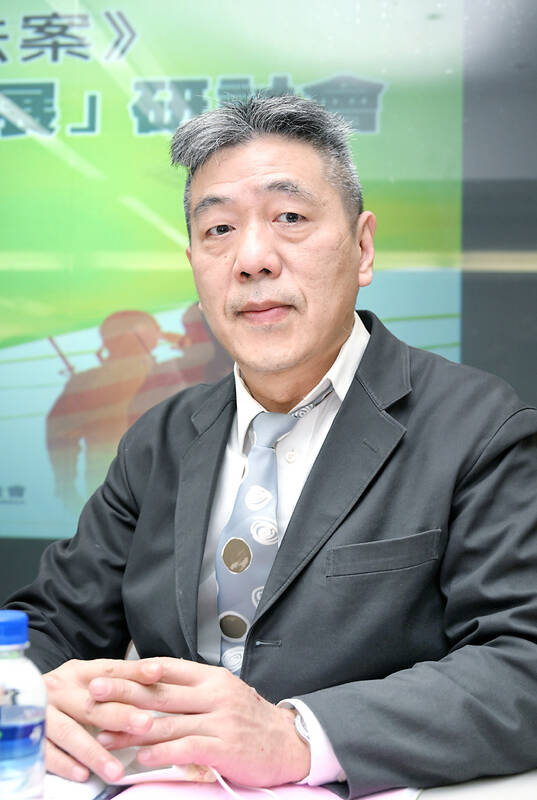The military backs the six defense-related technologies listed by the government as being among Taiwan’s 22 key core technologies to face stringent controls, due to national security reasons, the Ministry of National Defense said on Tuesday.
The six defense-related technologies include military-grade carbon fiber composite; carbon/carbon composite ablation materials; and interference rejection identification friend or foe (IFF) system technologies, the ministry said.
They also include military-grade technologies of microwave/infrared/multi-mode seeker, active phased array radar, and ramjet, a form of air-breathing jet engine that uses the forward motion of the engine to take in air for combustion that produces jet thrust, it said.

Photo: Fang Pin-chao, Taipei Times
The six technologies made the list according to recommendations by the ministry’s top research unit, the Chungshan Institute of Science and Technology (CSIST), to safeguard national security, it said in a statement.
The CSIST suggested the technologies based on two criteria, the ministry said.
First, Taiwan has an advantage in domestically developing or building those technologies, and second that it was urgent that they be put under government protection, the ministry said.
Institute for National Defense and Security Research fellow Su Tzu-yun (蘇紫雲) said the seeker technologies are particularly important.
The military-grade microwave/infrared/multi-mode seeker technology can enhance the ability of rocket and missile launch platform sensors to better identify and lock in enemy targets, including stealth aircraft, with the technology also used by fighter jets, uncrewed aerial vehicles and warships, he said.
Multi-mode seekers are being deployed for all kinds of rocket launchers, including the indigenous Hsiung Feng III supersonic anti-ship missile, Su said.
Beyond the benefits for the nation’s defense industry, the development of these key technologies can also support civilian purposes, such as applying the use of advanced infrared technology to autonomous vehicles, he said.
The six defense technologies were among 22 core technologies listed by the National Science and Technology Council (NSTC) to be under heightened controls to prevent technology leaks and bolster industrial competitiveness.
The 22 technologies cover five industries: defense, aerospace, agriculture, semiconductors and information and communications technology, the NSTC said.
“Key technologies” refer to technologies that, if exported to China, Macau, Hong Kong or “external hostile forces,” would significantly harm national security, industrial competitiveness, or economic development, the NSTC said, citing the National Security Act (國家安全法).
Those found obtaining trade secrets related to national core key technologies by way of “theft, embezzlement, fraud, coercion, unauthorized reproduction, or other improper methods, or using and disclosing them after obtaining them,” may face up to 12 years in prison and a fine of up to NT$100 million (US$3.17 million), as stipulated in the act.
SEE IC ON PAGE 12

SHIPS, TRAINS AND AUTOMOBILES: The ministry has announced changes to varied transportation industries taking effect soon, with a number of effects for passengers Beginning next month, the post office is canceling signature upon delivery and written inquiry services for international registered small packets in accordance with the new policy of the Universal Postal Union, the Ministry of Transportation and Communications said yesterday. The new policy does not apply to packets that are to be delivered to China, the ministry said. Senders of international registered small packets would receive a NT$10 rebate on postage if the packets are sent from Jan. 1 to March 31, it added. The ministry said that three other policies are also scheduled to take effect next month. International cruise ship operators

HORROR STORIES: One victim recounted not realizing they had been stabbed and seeing people bleeding, while another recalled breaking down in tears after fleeing A man on Friday died after he tried to fight the knife-wielding suspect who went on a stabbing spree near two of Taipei’s busiest metro stations, Taipei Mayor Chiang Wan-an (蔣萬安) said. The 57-year-old man, identified by his family name, Yu (余), encountered the suspect at Exit M7 of Taipei Main Station and immediately tried to stop him, but was fatally wounded and later died, Chiang said, calling the incident “heartbreaking.” Yu’s family would receive at least NT$5 million (US$158,584) in compensation through the Taipei Rapid Transit Corp’s (TRTC) insurance coverage, he said after convening an emergency security response meeting yesterday morning. National

PLANNED: The suspect visited the crime scene before the killings, seeking information on how to access the roof, and had extensively researched a 2014 stabbing incident The suspect in a stabbing attack that killed three people and injured 11 in Taipei on Friday had planned the assault and set fires at other locations earlier in the day, law enforcement officials said yesterday. National Police Agency (NPA) Director-General Chang Jung-hsin (張榮興) said the suspect, a 27-year-old man named Chang Wen (張文), began the attacks at 3:40pm, first setting off smoke bombs on a road, damaging cars and motorbikes. Earlier, Chang Wen set fire to a rental room where he was staying on Gongyuan Road in Zhongzheng District (中正), Chang Jung-hsin said. The suspect later threw smoke grenades near two exits

The Forestry and Nature Conservation Agency yesterday launched a gift box to market honey “certified by a Formosan black bear” in appreciation of a beekeeper’s amicable interaction with a honey-thieving bear. Beekeeper Chih Ming-chen (池明鎮) in January inspected his bee farm in Hualien County’s Jhuosi Township (卓溪) and found that more than 20 beehives had been destroyed and many hives were eaten, with bear droppings and paw prints near the destroyed hives, the agency said. Chih returned to the farm to move the remaining beehives away that evening when he encountered a Formosan black bear only 20m away, the agency said. The bear